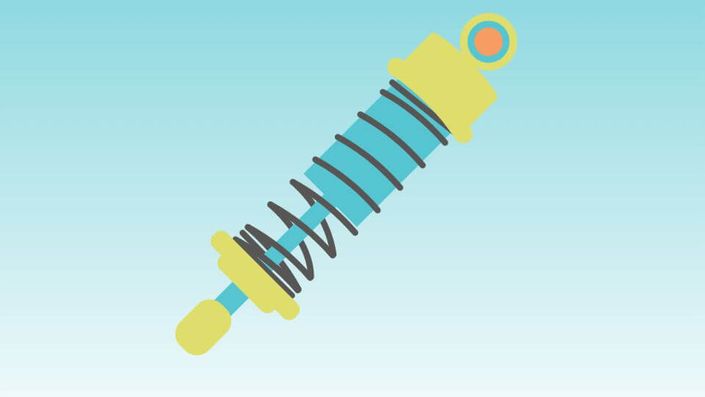
System Dynamics and Controls
All the Basics You Need to Know About Mathematical Modeling of Systems and Controls
Watch Promo
What is System Dynamics and Controls about?
This course provides a great introduction to controls and mathematical modeling of mechanical systems. What does that mean? Well, you will learn how to generate equations that can be used to model a body's motion.
Think of a pendulum swinging - after this course you will be able to model this type of motion using differential equations and matrices.
On top of that, you'll be able to analyze system stability, calculate how much error is present, use Laplace transforms to solve initial value problems and much, much more!
Here's some of what you will learn:
- Laplace transforms
- Transfer functions
- Response equations
- Equations of motion of mechanical and electrical systems
- First order response
- Second order response
- State space representation
- Block diagram reduction
- Stability and Routh's Criterion
- Steady state error analysis
- Root locus
Click here to see the full curriculum
And if that's not enough, for those wishing to use MATLAB, examples and applications are provided throughout the course. This helps gives more of a visual understanding of what's going on besides just looking at equations.
What's included in the course?
- 18.5 hours of on-demand video lectures that explain concepts in a simple manner
- 61 examples to improve your understanding and problem solving skills
- 12 homework sets with solutions to practice the concepts
- MATLAB examples with downloadable files that you can run yourself
- Downloadable outline of notes to help you create a set of organized notes and to follow along with the material
- Downloadable equation sheet and Laplace transform table
- Certificate of Completion once you finish the course
- Email access to the instructor in case you have questions
- 14-day money back guarantee so there's no risk to try it out. Please see the Terms of Use here for more details.
Who should enroll?
This course is perfect for you if:
- you're a current student in a similar class and are needing additional examples/explanations
- you're studying for the Fundamentals of Engineering exam and need a review of system response and block diagrams
- you're just curious and want to learn something new
Course Curriculum
-
Preview1.1 Laplace Transforms and Example 1 (10:47)
-
Preview1.2 Laplace Tables and Example 2 (10:58)
-
Preview1.3 Shifting Property and Example 3 (5:38)
-
Preview1.4 Differentiation Theorem of Laplace Transforms (5:36)
-
Preview1.5 Example 4 and Integration Theorem of Laplace Transforms (7:45)
-
Preview1.6 Example 5 (6:02)
-
Preview1.7 Example 6 (5:19)
-
Preview1.8 Example 7 (4:51)
-
Start1.9 Solving Linear Differential Equations (3:26)
-
Start1.10 Example 8 (8:02)
-
Start1.11 Example 9 (10:10)
-
Start1.12 Example 10 (11:49)
-
PreviewHomework 1
-
StartHomework 1 Solutions
-
StartMATLAB 1 - residue function (14:42)
-
StartMATLAB 2 - ilaplace function (9:07)
-
Start1.13 Mechanical Systems and Particles (7:49)
-
Start1.14 Rigid Bodies (7:09)
-
Start1.15 Example 11 (16:45)
-
Start1.16 Rigid Bodies Continued (4:47)
-
Start1.17 Example 12 (14:47)
-
Start1.18 Springs (5:57)
-
Start1.19 Friction Elements (10:36)
-
Start1.20 Mechanical Input and FBDs (5:30)
-
Start1.21 Example 13 (10:59)
-
Start1.22 Example 14 (4:54)
-
Start1.23 Example 15 (13:28)
-
Start1.24 Example 16 (11:32)
-
Start1.25 Example 17 (8:09)
-
Start1.26 Example18 (16:56)
-
Start1.27 Small Angle Approximation and Example 18.2 (4:27)
-
Start1.28 Example 19 (17:37)
-
Start1.29 Transfer Functions (10:26)
-
Start1.30 Example 20 (16:07)
-
Start1.31 Example 21 (14:14)
-
StartHomework 2
-
StartHomework 2 Solutions
-
Start1.32 Impedence Method (9:28)
-
Start1.33 Example 22 (12:28)
-
Start1.34 Example 23 (24:41)
-
Start1.35 Transfer Functions for Multiple Inputs and Outputs (15:50)
-
StartHomework 3
-
StartHomework 3 Solutions
-
Start2.1 State Space Representation (17:46)
-
Start2.2 Example 24 (10:34)
-
Start2.3 Example 25 (8:35)
-
Start2.4 Example 26 (11:18)
-
StartHomework 4
-
StartHomework 4 Solutions
-
StartMATLAB 3 State Space Numerical Integration (14:06)
-
StartMATLAB 4 Example 27 (8:12)
-
StartMATLAB 5 Example 26 (5:36)
-
Start2.5 Transfer Function to State Space (6:50)
-
Start2.6 Example 28 (7:48)
-
Start2.7 State Space to Transfer Function (7:30)
-
Start2.8 Example 29 (6:33)
-
StartHomework 5
-
StartHomework 5 Solutions
Your Instructor

Teaching is my passion. As a University professor I have taught 1000's of students and watched them transform from freshmen into successful engineers. Unlike many STEM professors, I believe in teaching complex material in simple, easy-to-understand terms. I teach my courses in a way I wish I had been taught: straightforward lectures with plenty of examples on how to apply the theory being learned.
In addition to University experience, I also worked as an engineer for 8 years in industry at a well-known defense company. This experience enables me to focus in on topics that are actually applicable in the real world, not just textbook problems.
Come learn with me!
Is any prior knowledge needed?
Yes! The typical math requirement for this course is Differential Equations and Linear Algebra. Dynamics...you need to know that too, as we will be modeling bodies in motion.
MATLAB is helpful but not required - I kept all the MATLAB examples separate for students not interested in that material.
What's the format of the course?
Let me just say that I hate engineering courses taught with PowerPoint slides. Due to this, you will not find slides here.
I think people learn better when they have to write the material. That means the majority of my lectures are handwritten. I give you a brief outline of notes to help you follow along and to help minimize the length of the videos.
Speaking of video length... am I the only one who doesn't like watching hour-long lecture videos? I didn't think so.
To eliminate that frustration my lectures are broken up into shorter segments, typically 12-15 minutes.
And if you are here for examples, I made them easy to find. Almost all the examples are in their own videos, that way you can look through the notes and pick and choose which ones you want to watch.
Do I need a book?
Would it be helpful to have a book? Yeah probably. Is it absolutely necessary? Probably not. The benefit of having a book is having more examples and problems to work on your own.
The book I recommend and always use for this course is Control Systems Engineering by Nise. It gets good reviews from students and it provides a solid foundation for more advanced controls classes.
Will this prepare me for other classes?
Most definitely! The fundamental knowledge gained in this course will be useful for study in areas like:
- Mechanical Vibrations
- Feedback Control Systems
- Kalman filtering
What are you waiting for? Enroll today!
Disclosure: The textbook link is an affiliate link. What does that mean? It means, at no cost to you, I will receive a small commission if you click through the link and purchase the book. This text is widely used and I have used it for years. Whether you buy it through this link or not I highly recommend this text.
